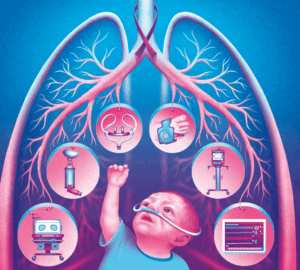Dec 2025: The concept of prematurity-associated lung disease or PLD together with the different phenotypes of lung disease (POLD, pPRISm and pDysanapsis) based on simple spirometry so can be diagnosed by the general practitioner or general paediatrician was developed from results from the RHiNO studies. These concepts together with long term trajectories of lung function and management of PLD were published in the top respiratory journal The Lancet Respiratory Medicine Journal in December 2025:
- Course CW, Bush A, Kotecha S. Looking beyond bronchopulmonary dysplasia: prematurity-associated lung disease and its phenotypes. Lancet Respir Med 2025; published online Nov 27.
- Du Berry C, Gray DM, Bates A, et al. Trajectories of prematurity-associated lung disease: lifelong lung health. Lancet Respir Med 2025; published online Nov 27.
- Duijts L, Um Bergström P, Kotecha SJ, Kotecha S, Pijnenburg MW. Management of prematurity-associated lung disease from infancy through to adulthood. Lancet Respir Med 2025; published online Nov 27.
Comment:
Profile:
- Sailesh Kotecha—preterm birth respiratory medicine expert Tony Kirby, The Lancet Respiratory Medicine
Podcast: In conversation with Sailesh Kotecha….
View the series on PLD at: https://www.thelancet.com/series-do/prematurity-associated-lung-disease

2025: Additional publications published from the RHiNO data jointly by Dr John Watkins and by Dr Chris Course studying the effects of pollution on the preterm lung and by Dr Michael Cousins together with teams from Budapest, Hungary and Brisbane, Australia on intra-breath mechanics of the newly defined phenotypes of pematurty-associated lung disease (PLD):
Course CW, Lewis PA, Kotecha SJ, Cousins M, Hart K, Heesom KJ, Watkins WJ, Kotecha S. Similarities of metabolomic disturbances in prematurity-associated obstructive lung disease to chronic obstructive pulmonary disease. Sci Reports 2024;14:23294. https://doi.org/10.1038/s41598-024-73704-1
Cousins M, Hart K, Radics B, Henderson AH, Hantos Z, Sly PD, Kotecha S. Intra-breath respiratory mechanics of phenotypes of prematurity-associated lung disease in school-aged children? Eur J Respir Open 2025 11(2): 00840-2024
July 2024: Additional papers have been published to try to understand the nature of the lung disease that children born prematurely can get – these are shown on the publications page – click here.
The data from the clinical trial in RHiNO was published in 2022 showing that a combination of inhaled corticosteroids and long acting beta2 agonists (ICS/LABA) combination improved the children’s lung function by 15% on average. The findings were published in JAMA Pediatrics in 2022: